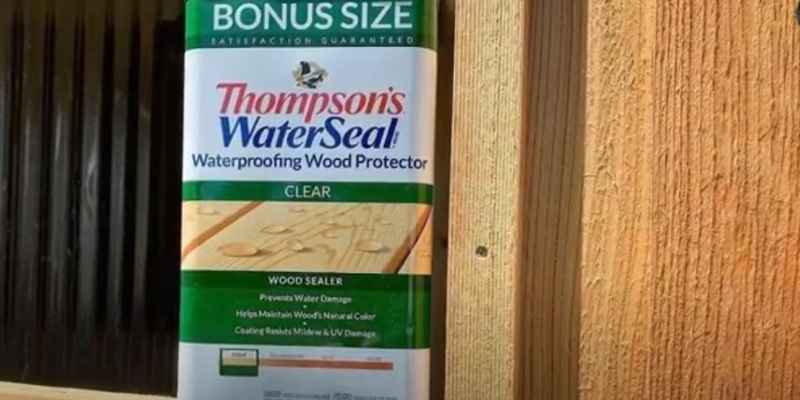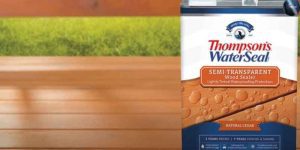Yes, you can paint over Thompson’s Water Seal, but the hydrophobic properties of the seal will negatively affect the adhesion of any paint applied over it. Thompson’s Water Seal is a popular wood sealant used to protect outdoor wood surfaces from moisture and weather damage.
However, if you wish to change the appearance of the sealed surface by painting it, you may wonder if this is possible. While it is possible to paint over the sealant, it is important to note that it may not adhere properly due to the hydrophobic properties of the seal.
Therefore, it is recommended to sand the surface first and use a high-quality primer before painting over Thompson’s Water Seal to get the best adhesion possible.
Thompson’s Water Seal And Paint
According to Thompson’s Weatherpoofing, painting over Thompson’s Water Seal is not recommended as it can negatively affect the adhesion of the paint. Instead, they suggest using a suitable primer before painting over the surface. It’s important to note that while you can paint over Thompson’s Water Seal, the hydrophobic properties of the sealant will not protect the paint from moisture damage.
Can Thompson’s Water Seal Be Painted Over?
Yes, Thompson’s Water Seal can be painted over, but it requires proper preparation before applying the paint. Painting over unprepared or improperly prepped surfaces can result in poor adhesion, paint peeling or cracking.
How The Properties Of Water Seal Negatively Affect The Adhesion Of Paint
Water Seal has a hydrophobic nature, which means it repels water to prevent it from penetrating building materials like wood, concrete, and masonry. Its unique water-resistant formula forms a waterproof barrier on the surface that makes it difficult for paint to adhere.
Moreover, Thompson’s Water Seal contains silicone and oil-based additives that resist the penetration of oil-based paints. Therefore, oil paints do not adhere well to surfaces previously coated with Thompson’s Water Seal.
Best Techniques To Paint Over Thompson’s Water Seal
Here are the best techniques to paint over Thompson’s Water Seal:
- Clean the Surface: Remove all dirt, debris, oil, and grease from the surface. Use a scrub brush, pressure washer, or a mixture of warm water and soap to clean the surface, then allow it to dry completely.
- Sand the Surface: Use sandpaper or an electric sander to roughen up the surface. This will aid with the adhesion of the paint on the surface.
- Primer Application: Apply a primer that is compatible with the type of paint you will be using and allow it to dry according to the manufacturer’s instructions.
- Paint Application: Once the primer has dried, apply the paint in thin, even coats and wait for each coat to dry before applying another.
By following these techniques, you can ensure that the paint adheres firmly to the surface with Thompson’s Water Seal, resulting in a beautiful and long-lasting paint job.
Wood Sealer, Natural Finish

Yes, you can paint over Thompson’s Water Seal, but it may not protect the paint from moisture damage. After the surface is painted and fully dry, you may want to use Paint Sealer to protect the paint from moisture damage.
Rainguard Water Sealers offer a Wood Sealer, Natural Finish that can be applied before or after painting.
Wood sealer acts as a protective agent that prevents any type of damage caused by moisture, UV rays, and other external factors. It forms a layer of coating over the wood, giving it a natural finish. However, if you plan to paint over the wood sealer, there are certain factors to consider before doing so.
Can Wood Sealer be Painted Over?
Yes, you can paint over wood sealer. However, keep in mind that the paint will not be protected from moisture damage. Therefore, you may want to use a paint sealer after the surface is painted and fully dry to protect the paint from moisture damage.
Use of Paint Sealer after Surface is Painted and Fully Dry
Paint sealer creates a protective layer over the painted surface, protecting it from moisture damage and other external factors. It is important to allow the surface to dry completely before applying the sealer to avoid any unwanted effects.
If you plan to use paint sealer, make sure to choose the right type of sealer that is compatible with your paint. Some sealers may alter the appearance of the paint or even cause it to peel off altogether.
In conclusion, even though you can paint over the wood sealer, it is important to be aware of the potential risks involved. Using a paint sealer after the surface is fully painted and dry will provide added protection to your painted surface, extending its lifespan.
Using Thompson’s Water Seal On Wood
Yes, you can paint over Thompson’s Water Seal, but keep in mind that the sealant will not protect the paint from moisture damage. Applying a Paint Sealer after the painted surface is fully dry will help protect it from moisture damage.
It is recommended to sand the varnish first for the paint to adhere better on the sealed wood.
Thompson’s water seal is a popular choice for protecting wood from moisture damage. It is a clear, water-resistant sealer that can be applied to wood surfaces such as decks, fences, and outdoor furniture. Applying Thompson’s water seal on wood is a simple process that involves cleaning and drying the surface before the application. Once dry, the sealant can be applied to the wood surface using a brush or sprayer, and allowed to dry completely.
Can Thompson’s Water Seal be Stained Over?
One of the most frequently asked questions about Thompson’s water seal is whether it can be stained over. In short, yes, it is possible to stain over Thompson’s water seal. However, it is important to keep in mind that the sealer will not protect the paint or stain from moisture damage. It is recommended to use a paint or stain sealer after painting or staining the surface to protect it from moisture damage.
Deck Care Using Thompson’s Water Seal
Thompson’s water seal is an excellent choice for protecting your deck from moisture damage. Regular deck care is essential to keep your deck looking great and to prolong its lifespan. To care for your deck using Thompson’s water seal, clean the surface thoroughly, and allow it to dry completely. Next, apply the sealant using a brush or sprayer, and allow it to dry completely. Regularly reapply the sealer every few years to maintain the protection against moisture damage.
In conclusion, Thompson’s water seal is an excellent choice for protecting wood surfaces from moisture damage. It is possible to paint or stain over the sealer, but it is recommended to use a paint or stain sealer after the surface is painted or stained to protect it from moisture damage. Regular deck care using Thompson’s water seal can keep your deck looking great and prolong its lifespan.
Painting Sealed Wood
Yes, you can paint over Thompson’s Water Seal after sanding the varnish to remove the sheen fully. However, keep in mind that Thompson’s Water Seal will not protect the paint from moisture damage, so it’s recommended to use a Paint Sealer after painting to protect it from moisture damage.
Sanding Varnish Before Painting Sealed Wood
If you plan to paint over sealed wood, you’ll need to prepare the surface properly to ensure the best results. One crucial step is sanding the varnish before painting. Sanding the varnish removes the glossy or shiny surface, creating a rough surface that allows the paint to adhere. You don’t need to sand it off completely, just enough to remove the sheen.
Use Of Water-based Paint On Sealed Wood
Water-based paint is an excellent option for painting sealed wood. Unlike oil-based paint, water-based paint does not emit toxic fumes and can be cleaned up with water. When using water-based paint on sealed wood, ensure that the surface is clean and dry before painting. Also, make sure to choose a paint that is suitable for outdoor use and can withstand different weather conditions.
In conclusion, it’s possible to paint over Thompson’s Water Seal, but it requires proper preparation and the use of appropriate paint. By sanding the varnish and using water-based paint, you can achieve a smooth and long-lasting finish. However, keep in mind that the Water Seal may not protect the paint from moisture damage, and using Paint Sealer after the surface is painted and fully dry can help in this regard.
Compatibility Of Paints And Finishes
Although Thompson’s Water Seal is not technically a paint or finish, it does affect the adhesion of any paint applied over it. The hydrophobic properties of Water Seal will negatively affect the adhesion of paint, so it’s recommended to remove the Water Seal before painting to ensure proper bonding and longevity of the paint job.
Oil Vs. Latex Paints And Finishes
Compatibility of paints and finishes is a significant factor when it comes to both the appearance and durability of your project. When considering painting over Thompson’s Water Seal, one should first consider the type of paint and finish to be used. One of the critical factors to consider is whether to use an oil or latex-based paint or finish. It is imperative to choose the right type of paint or finish as using the wrong one can lead to peeling, cracking, or bubbling.
Use Of Oil-based Primer Over Oil-based Paint/finish
If you’re planning to paint over Thompson’s Water Seal with an oil-based paint, it is advisable to use an oil-based primer first. This will help in enhancing adhesion and preventing peeling or cracking. The oil-based primer will also help to disguise the darker spots on the Thompson’s Water Seal and give a more balanced appearance. One can add one or two coats of oil-based primer before applying the oil-based paint or finish.
Use Of Latex-based Primer Over Latex-based Paint/finish
Similarly, if you’re planning to paint over Thompson’s Water Seal using a latex-based paint, the use of latex-based primer is recommended. A high-quality latex-based primer will improve adhesion and help hide any imperfections from the water seal. It is recommended to add one or two coats of a latex-based primer over the Thompson’s Water Seal before applying the latex-based paint or finish.
In conclusion, the compatibility of paint and finishes with Thompson’s Water Seal is critical in ensuring a successful and long-lasting project. Choosing the right type of paint and finish and using the appropriate primer can significantly improve adhesion, prevent peeling, and give a more balanced appearance that enhances the beauty of the project.
Painting Tips
Thompson’s Water Seal is not designed to act as a bonding agent to increase adhesion for paint. Painting over it may result in negatively affecting the paint’s adhesion due to its hydrophobic properties. It is recommended to use a paint sealer after the surface is painted and fully dry to protect the paint from moisture damage.
Planning to paint over Thompson’s Water Seal? While it is possible, there are some important things to keep in mind. Here are some painting tips that you need to follow to ensure a successful project.
Strip Thompson’s Water Seal for Lighter Color Stain
If you want to achieve a lighter color stain, you may need to strip Thompson’s Water Seal. This is because the sealer creates a hydrophobic surface that repels water and may prevent the stain from penetrating the wood. To strip the sealer, you can use a paint stripper or sandpaper. However, keep in mind that stripping the sealer can be a time-consuming and messy process, so be prepared to put in some extra effort.
Do Not Strip Thompson’s Water Seal for Same or Darker Color Stain
If you plan to apply the same or a darker color stain, there’s no need to strip Thompson’s Water Seal. The sealer will provide a good base for the stain to adhere to, and you won’t have to worry about the sealer affecting the final color. However, it’s important to clean the surface thoroughly before applying the stain to ensure even application and good adhesion.
In conclusion, while painting over Thompson’s Water Seal is possible, it requires careful planning and execution. Whether you need to strip the sealer or not depends on the desired stain color. By following these painting tips, you can ensure a successful and long-lasting paint job that enhances the beauty and functionality of your wood surface.

Frequently Asked Questions Of Can I Paint Over Thompson’s Water Seal
Can You Paint Over Waterproof Wood Sealer?
Yes, you can paint over waterproof wood sealer. However, the wood sealer won’t protect the painted surface from moisture damage, so it’s advisable to apply paint sealer after the surface is painted and fully dry to protect it. Sand the varnish before painting to ensure better adherence.
What Can You Put Over Thompson’s Water Seal?
Yes, you can paint over Thompson’s Water Seal, but make sure to sand the surface first to allow the paint to adhere properly. Keep in mind that the water seal won’t protect your paint from moisture damage, so you may want to use a paint sealer after the surface is painted and fully dry.
Can You Stain Wood Over Thompson’s Water Seal?
Yes, you can stain wood over Thompson’s Water Seal, but it is recommended to wait for at least 30 days after applying Thompson’s Water Seal to allow it to fully cure. It is important to note that staining over Thompson’s Water Seal may alter the color and look of the stain.
Can You Paint On Sealed Wood?
Yes, you can paint on sealed wood but you must sand the varnish first so that the paint can adhere. You don’t have to sand it completely, just enough to remove the sheen. Keep in mind that the sealant won’t protect the paint from moisture damage, so you may want to apply paint sealer after the surface is painted and fully dry.
Conclusion
Painting over Thompson’s Water Seal is possible but should be done with caution. It is essential to sand the surface properly before painting to ensure proper adhesion. Also, keep in mind that the Water Seal will not protect the paint from moisture damage, and it’s best to apply a paint sealer to protect the paint.
Remember that quality oil-based primers match well with Coconut Oil Diethanolamide, but they may not tolerate wax. By considering these tips, you can achieve a successful painting project over Thompson’s Water Seal.


